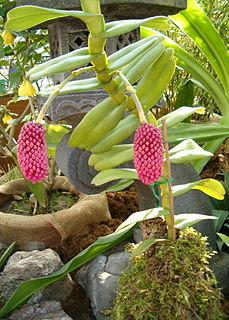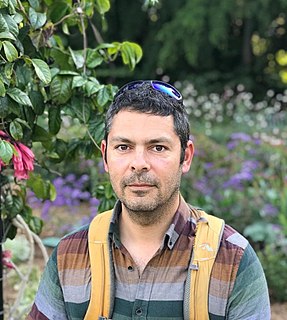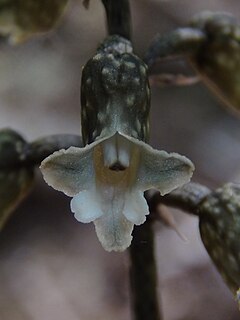
Ipsea is a genus of the Orchid family (Orchidaceae), with three species that are found in India, Sri Lanka and Thailand.
Adrorhizon purpurascens is a species of orchid. It is the only species in the genus Adrorhizon and one of three genera in the subtribe Adrorhizinae.

Gastrodia, commonly known as potato orchids or as 天麻属 , is a genus of terrestrial leafless orchids in the family Orchidaceae, about ninety of which have been described. Orchids in this genus have fleshy, upright stems and small to medium-sized resupinate flowers with narrow sepals and petals. They are native to Asia, Australia, New Zealand, central Africa, and various islands of the Indian and Pacific Oceans.
Platanthera calceoliformis is a species of orchid endemic to north-western Yunnan province, China. It is found at altitudes of 3,200–4,000 metres (10,500–13,100 ft) in alpine grasslands. It is listed as an endangered species on the IUCN Red List.

Didymoplexis, commonly known as crystal orchids or as 双唇兰属 , is a genus of terrestrial leafless orchids in the family Orchidaceae, about twenty species of which have been described. Orchids in this genus have swollen, fleshy rhizomes and thin, pale, upright fleshy flowering stems with resupinate, bell-shaped white or pale yellowish brown flowers. They are native to Africa, Madagascar, Southeast Asia, Australia and various islands of the Pacific.

Robiquetia, commonly known as pouched orchids, or 寄树兰属 , is a genus of flowering plants from the orchid family, Orchidaceae. Plants in this genus are epiphytes with long, sometimes branched, fibrous stems, leathery leaves in two ranks and large numbers of small, densely crowded flowers on a pendulous flowering stem. There are about eighty species found from tropical and subtropical Asia to the Western Pacific.

Trichoglottis, commonly known as cherub orchids or 毛舌兰属 , is a genus of flowering plants in the family Orchidaceae. Orchids in this genus are epiphytic plants with thick roots, relatively thick, fibrous stems and many large, thick, leathery leaves arranged in two ranks. The flowers are usually small and yellowish with light brown or purple markings. The flowers have broad sepals, narrower petals and a labellum which has three lobes and is often hairy. There are about 85 species distributed from tropical and subtropical Asia to the north-western Pacific. Most species grow in rainforest.

Eulophia pulchra, commonly known as the gonzo orchid, is a plant in the orchid family and is native to areas from Tanzania and Mozambique to the Western Pacific Ocean. It is a terrestrial orchid with crowded, above-ground pseudobulbs, two or three leaves and pale yellowish green flowers with dull purple or red markings. It grows in plant litter in rainforests.
Erythrodes is a genus of flowering plants from the orchid family, Orchidaceae. It contains 26 currently recognised species, native to Southeast Asia, China, the Indian Subcontinent, New Guinea, and some islands of the Pacific.
- Erythrodes amboinensis(J.J.Sm.) J.J.Sm. - Ambon
- Erythrodes bicalcarata(R.S.Rogers & C.T.White) W.Kittr. - New Guinea
- Erythrodes bicarinataSchltr. - New Guinea, Vanuatu
- Erythrodes blumei(Lindl.) Schltr. in K.M.Schumann & C.A.G.Lauterbach - from Assam east to Taiwan, south to Java
- Erythrodes boettcheriAmes - Luzon
- Erythrodes celebensisP.O'Byrne - Sulawesi
- Erythrodes forcipataSchltr. - New Guinea
- Erythrodes glandulosa(Lindl.) Ames - Borneo
- Erythrodes glaucescensSchltr. - New Guinea
- Erythrodes hirsuta(Griff.) Ormerod in G.Seidenfaden - Hainan, Assam, Bhutan, Myanmar, Thailand, Vietnam
- Erythrodes humilis(Blume) J.J.Sm. - Java, Sumatra, peninsular Malaysia
- Erythrodes johorensis(P.O'Byrne) Ormerod - peninsular Malaysia
- Erythrodes latifoliaBlume - Java, Sumatra, peninsular Malaysia
- Erythrodes latilobaOrmerod - Sri Lanka
- Erythrodes oxyglossaSchltr. - Fiji, New Caledonia, Samoa, Tonga, Vanuatu, Wallis & Futuna
- Erythrodes papuanaSchltr. in K.M.Schumann & C.A.G.Lauterbach - New Guinea
- Erythrodes parvulaKores - Fiji, Tonga
- Erythrodes praemorsaSchltr. - New Guinea
- Erythrodes purpurascensSchltr. in K.M.Schumann & C.A.G.Lauterbach - New Guinea, Fiji, Tonga, Samoa
- Erythrodes sepikanaSchltr. - New Guinea
- Erythrodes sutricalcarL.O.Williams - New Guinea
- Erythrodes tetrodontaOrmerod - New Guinea
- Erythrodes torricellensisSchltr. - New Guinea
- Erythrodes trilobaCarr - Sabah
- Erythrodes weberiAmes - Philippines
- Erythrodes wenzeliiAmes - Philippines

Hetaeria, commonly known as hairy jewel orchids, is a genus of about thirty species of flowering plants in the orchid family Orchidaceae. Plants in this genus are terrestrial herbs with a succulent rhizome and a loose rosette of leaves. Small, pale, hairy non-resupinate flowers are borne on a thin, hairy flowering stem. They are found in tropical Africa and Asia to New Guinea, Australia and some Pacific Islands.

Peristylus, sometimes commonly known as ogre orchids or bog orchids is a genus of flowering plants from the orchid family, Orchidaceae. It consists of over 100 known species found across much of eastern and southern Asia as well as in Australia and on many islands of the Indian and Pacific Oceans.
Hunteria zeylanica grows as either an evergreen shrub or as a tree up to 15 metres (49 ft) tall, with a trunk diameter of up to 34.5 centimetres (13.6 in). Its flowers feature a white corolla. The berries are yellow. Its habitat is forests from sea level to 350 metres (1,150 ft) altitude. The trees can withstand salinity. Local medicinal uses include for stomach-ache. Hunteria zeylanica wood is used for weapon handles and as firewood. In Africa, the plant is native to Kenya and Tanzania and in Asia it is native to China, India, Sri Lanka, Indochina and western Malesia.

Carlos Adolfo Lehnebach is a New Zealand botanist. He is employed as a botany curator at the Museum of New Zealand Te Papa Tongarewa. Lehnebach studies New Zealand orchids. As of January 2018, he has described seven new species of orchid and two species of forget-me-not (Myosotis) indigenous to New Zealand.
Gastrodia queenslandica, commonly known as rainforest bells, is a leafless terrestrial mycotrophic orchid in the family Orchidaceae. It has one or two small, yellowish brown, tube-shaped flowers on a thin, brittle flowering stem and grows in rainforest in tropical north Queensland, Australia.

Gastrodia cooperae, also known as Cooper's black potato orchid, is a species of plant in the family Orchidaceae and is endemic to New Zealand. The specific epithet cooperae refers to Dorothy A. Cooper, founder of the New Zealand Native Orchid Group.
Gastrodia molloyi is a species of plant in the family Orchidaceae. It is endemic to New Zealand. It was first formally described in 2016 by Carlos Adolfo Lehnebach and Jeremy Rolfe and the description was published in the journal Phytotaxa. The specific epithet (molloyi) honours the New Zealand botanist, Brian Molloy.

Gastrodia procera, commonly known as the tall potato orchid, is a leafless terrestrial mycotrophic orchid in the family Orchidaceae. It has a robust, dark brown to blackish flowering stem with up to seventy cinnamon brown, tube-shaped flowers that are white inside. It grows in high rainfall forest in southeastern Australia.
Gastrodia gunatillekeorum is a new species of potato orchid discovered in Sinharaja rainforest and described in 2020. Each with less 100 mature individuals, only three small populations have been discovered as yet. This plant was named after Nimal Gunatilleke and Savithri Gunatilleke.
Gastrodia spatulata is a species of Gastrodia native to Indonesia and Malaysia. It is known from Borneo and Java.
Gastrodia agnicellus is a species of orchid in the genus Gastrodia, found in Madagascar and described in Curtis's Botanical Magazine by Johan Hermans in 2020. It has been said to be "the ugliest orchid in the world", with "brown, fleshy and grotesque" flowers. Like all species in its genus, it is leafless and mycotrophic.










